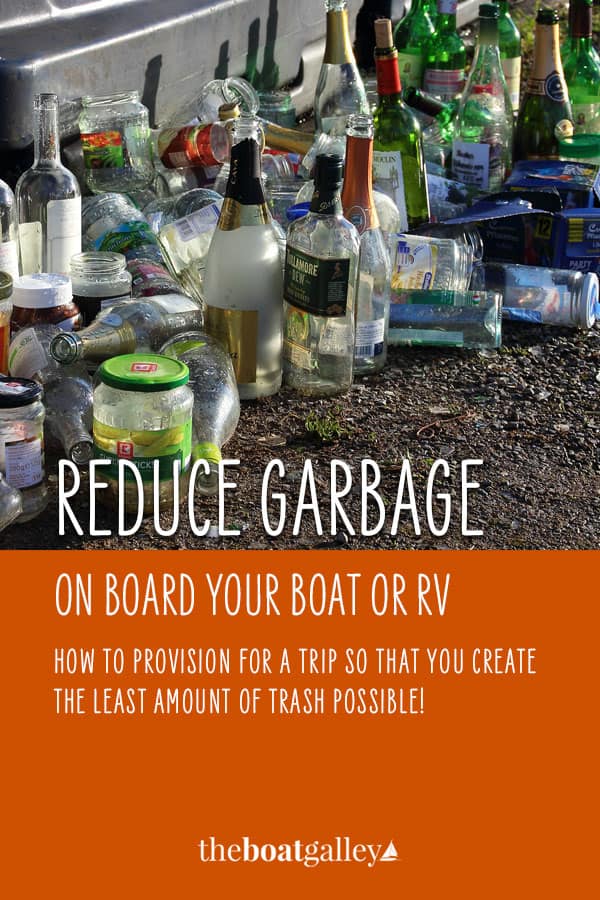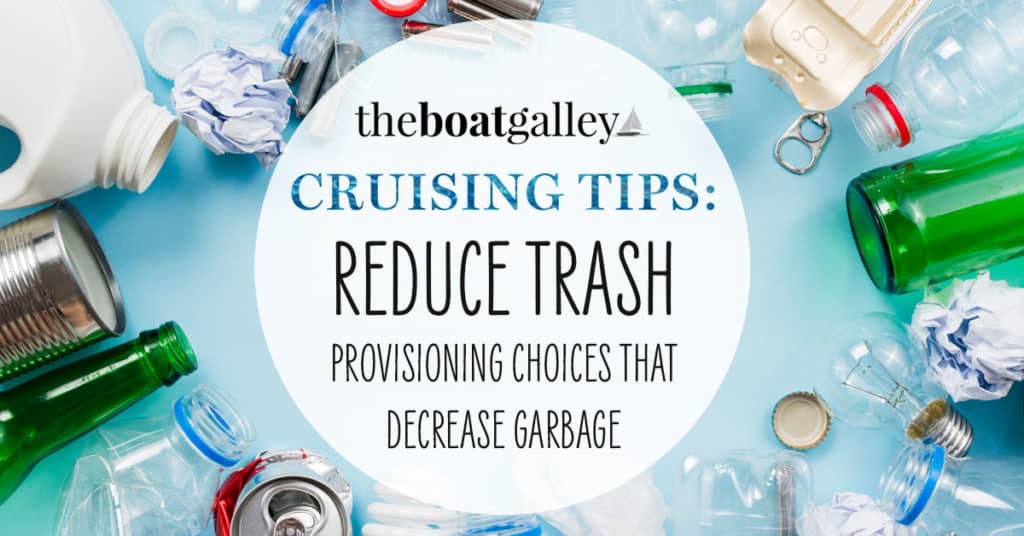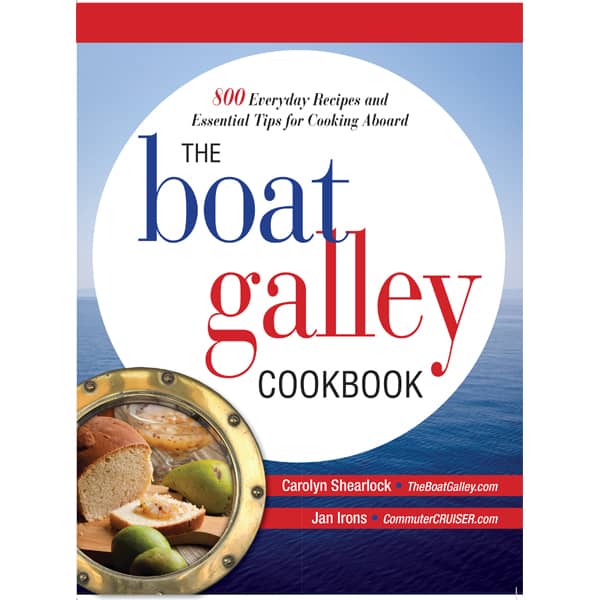
Trash can easily get out of control on a boat — there just isn’t much space for it. The best way to reduce trash on the boat is to think about the trash your provisioning choices will generate. If you’re a beer drinker, for example, empty cans can be crushed while bottles can’t – and that’s a considerable saving in space.
The longer we have cruised, the more I have considered packaging in my provisioning choices. I considered not just how much trash a particular item would generate, but whether I could get rid of some of that trash before we even left port – or better yet, before I even took it aboard.
Here are ten ways that I reduce the trash on our boat.
- For things that have to be stored in a container – say tuna or mayonnaise – you can often buy them in pouches instead of cans or jars. The pouches can be totally flattened when empty and take up almost no space. Buying wine in boxes – either Tetra Paks or pouches inside cardboard boxes — produces far less trash volume than bottles.
- If something comes in a cardboard box, see if there is an inner liner so that you can get rid of the cardboard before taking the item to the boat (be sure to save any directions). That inner liner will crumple up into just a small ball, whereas a box will take quite a bit more space to store when emptied – even if you break it down and flatten it. Two other advantages of getting rid of the cardboard and only taking the liner aboard are that it will take less space to stow and the cardboard won’t provide a home for bugs.
- With canned food, see if you’ll be able to remove the bottom of the can with a can opener – if so, you’ll be able to totally flatten the can. Many cans now have integrated bottoms that can’t be removed and they’re harder to completely flatten.
- When possible, choose cans over plastic jars or bottles and plastic over glass – they can be flattened more completely. (Not to mention less likely to break!)
- Tetra paks – those boxes that juice and many other things come in, including “canned” vegetables and sauces – can be totally flattened when empty. Another advantage of them is that they are square and pack tightly together when stowing, unlike round cans. Unfortunately, they cannot be burned and few places can recycle them.
- Does one of several options come in a container that you can re-use for another purpose? For example, I chose which brand of juice I bought for several months to collect enough of the “perfect size” bottles to use as small storage bins (with the tops cut off) in a particular locker. On another occasion, I chose my laundry soap by which bottle would work to make a dinghy bailer. Using it for something else is one of my favorite ways to reduce trash on our boat!
- In many places outside the US, eggs are sold individually and NOT in cartons. When you’re in a big city, buy your eggs in a Styrofoam carton and you’ll be able to reuse it many times (cardboard ones can harbor bugs and so should not be saved and re-used).
- Be wary of “resealable” containers that aren’t. Many packages say they are resealable, leading you to think that you won’t have to put the contents in a Ziploc once opened. They are usually a little larger than non-“resealable” containers, but you figure that it’ll be a smaller volume of trash in the long run. The problem is that the seal on many “resealable” pouches just isn’t up to multiple openings – or moving around with the motion of a boat. They’ve almost always failed on me and I’ve ended up having to use a Ziploc in addition to the larger original package. And that means a larger total volume of trash than if I’d planned to use in Ziploc in the first place!
- Look to see how much of the packaging can be left ashore – what looks to be more packaging may end up being less that actually has to go on the boat.
- Is it an item that can be quickly re-packaged aboard the boat so that the “big” packaging can be discarded ashore before leaving? A jar of peanuts, for example, can quickly be dumped into a Ziploc. Meat can be taken off its Styrofoam tray and put in a bag or vacuum-sealed.
I realize that the last two suggestions may not be considered the best choice from an environmental standpoint. Yes, we should reward manufacturers who use fewer resources (#9) and we shouldn’t create additional trash in the long run just because we don’t like how something is packaged (#10). But the reality is that sometimes in cruising, we have to make choices based on what actually works.
Read Next

Carolyn Shearlock has lived aboard full-time for 17 years, splitting her time between a Tayana 37 monohull and a Gemini 105 catamaran. She’s cruised over 14,000 miles, from Pacific Mexico and Central America to Florida and the Bahamas, gaining firsthand experience with the joys and challenges of life on the water.
Through The Boat Galley, Carolyn has helped thousands of people explore, prepare for, and enjoy life afloat. She shares her expertise as an instructor at Cruisers University, in leading boating publications, and through her bestselling book, The Boat Galley Cookbook. She is passionate about helping others embark on their liveaboard journey—making life on the water simpler, safer, and more enjoyable.
Simplify meal prep on board with proven strategies for provisioning, maximizing fridge space, and cooking delicious meals aboard your boat.










Bob Bechler says
Guess it depends on where you cruise too. We do ours in the Pacific and many places we visit are islands that have their own garbage problems that we don’t want to add to. All of out garbage except plastic goes overboard. Bottles are broken on the aft steering mount, cans are punctured and sunk, paper cut into pieces, food..of course. The cans and bottles sunk in 5000′ of water are not coming back. We burn the plastic in fire circles on the beach.
The idea of pouches over cans just adds to the garbage that needs to be burned of otherwise dealt with. In addition, if you ever get a rodent, our experience in a yard, they eat thru pouches in a heartbeat. Messy!!
Carolyn Shearlock says
Thanks for adding this, Bob — really valid point that cruising locale and the local trash situation also plays a part in choices.
At least part of my recommendations are definitely far more valid for places where there’s decent trash service. But the bottom line is still the same for all of us: thinking about the trash and what we’ll do with it right when we buy something. And if it has to go overboard instead of into a trash bag for later disposal where there IS decent trash service, your choices may be different!
-C
Helen says
I think garbage reduction is they way we should all think no matter where in the world we are….proper incineration and recycling are the only reasonable ways to dispose of garbage.
stacy hall says
I think Bob is right–keep the plastic to a minimum–It’s destroying our seas! We try to avoid the BPA in plastics and cans anyway for health reasons. We recycle(even when on land) glass wide mouth jars for leftovers-just as easy as a plastic container.
Carolyn Shearlock says
It’s tough to figure out what to use on the boat . . . I’m not wild on having any more glass on the boat than I have to, either. If it breaks, it’s possible to get a nasty cut reaching into a locker unknowingly . . . or cleaning it up.
Kathy says
I just would like to say I have encountered many an illegal fire pit on islands in Maine where someone burned their trash. Quite often someone collects rocks, builds a little circle, collects wood, and burned everything from plastic to tin cans. And this is usually done ABOVE the high tide line. This is exceptionally bad form. Not only is the trash still there for anyone to see or walk through, the rocks and sometimes surrounding environment is damaged from the fire and the whole thing left behind just encourages others to do the same. I don’t know about remote islands outside the US, but NO ONE should build a fire on small islands in the US unless it’s with permission, on the beach in the tidal zone, WITHOUT using rocks, and never, never burn your trash.
Mark Ski says
That is not right at all. You’re causing pollution!
Carolyn Shearlock says
Remember that trash has to go somewhere. Just because it gets picked up by a trash service does not mean it doesn’t cause pollution. And in many places, recycling simply does not exist.
Dawn Rodney says
If you are able to re-use the ziploc baggies by washing and sanitizing them then you can reduce and reuse all at once. I have been washing my baggies for years until they wear out.
Waterwoman says
We use Lock N Lock egg containers while at home and will be taking them with us when we cruise again. Previously, we used the plastic containers from the camping store.
We would keep “burnable” items separate and have a beach fire (below the water line).
Carolyn Shearlock says
Thanks Waterwoman!
Those Lock & Lock container are great — even better than finding a Styrofoam egg carton. They won’t pop open and they do a good job of protecting the eggs against breakage. If you’re curious what they are or want one, take a look on Amazon (I haven’t seen them in local stores, but I live in a town of 20,000):
Lock & Lock egg containers at Amazon
-C
Dawn says
We used a Soda Stream maker to eliminate having to store & get rid of drink cans/2 liter plastic. Our favorite was Tonic Water & Ginger ale. Both better than store bought; less calories. This machine uses CO2 cylinder & no electricity to work.
Carolyn Shearlock says
I think they’re great! Here’s what I wrote about the Soda Stream: https://theboatgalley.com/sodastream/
Eva Persson says
Dawn, have you had difficulties getting new cylinders? In what countries or regions?
Mia says
Plastic containers from youghurt, peanut butter, etc is reused on our boat for either left overs or to store other items. A peanut butter jar can be great for nuts and seads for example, and a youghurt container for leftover pasta, chili or other food. I am not a big fan of zip lock bags because they are hard to wash if used with anyting smelly or oily and end up in the trash quicker than a container would…
Gallon size water bottles can easily be refilled in the next marina instead of thrown out, make sure they have screw on top though.
sue says
Another great article, Carolyn
Sodastreams are great if you can get gas cylinders for them. Not available in SE Asia. Rubbish disposal is also a big problem there. More reason to use as little packaged goods as possible…get fresh from the local market, help those small economies, reduce rubbish and keep the environment safe and healthy. Buy wisely and make sure we do not burden our hosts or their homelands with more rubbish than is already there
[email protected] says
Great topic and thanks for bringing up the subject! I agree that plastic should be the last possible choice and I buy cans and glass over it if that is an option. To keep glass from breaking, just wrap bottles and jars in a sock. For things that I use a lot – cooking oils and sauces, I stick them in coolie cups. Never had a break. And when it’s empty, just return it to the same spot as the full replacement goes, or where it came from. If there is room to take it, there is room to hold onto it. Plastic can usually be cut up into small pieces to reduce space in the trash bag. I store stinky plastic (cheese wrappers) in the fridge or freezer in one big freezer ziplock until I can dispose of properly, Keeps the trash from smelling. Just what works aboard Tenaya…..
Kenneth Arnold says
I keep my home made Wine in a 5 gal water cooler type bottle, then re-use the bottle to make more!! I also re-use 1/2 gal. Juice jugs for fresh water. All foods are unpacked and magic marker directions on inside packaging and dump cardboard in the dumpster. Hows that?? 🙂
Carol Simmons says
Our grandson had a cast net that had holes in it – and was throwing it out since it could not be further repaired. We cut the ripped net off, but kept the circular edge of lead weights. We have mosquito netting for our main hatch and put the lead weight ring around the netting. It works!
Tom Hoffman says
Soda stream has been great for reducing trash.
The Boat Galley says
As long as you’re in a place where you can get the gas it’s great!
Gaynor Portlock says
Looks like wine in boxes is going to become my new best friend
Carolyn Shearlock says
Thanks Sheryl!
Gwen Hamlin says
Oh, but it tastes so much better in a bottle and the bottles are returnable in Negra Modelo-land!
Jason Ellis says
I know I’m gonna get hammered for this comment – also, it pays to be aware of rules for discarding waste offshore. X miles out for paper, metal, etc. I’m not advocating dumping your trash offshore, but the reality is that the aluminum tuna can will degrade much faster at the bottom than the plastic pouch will in a landfill.
Dave Skolnick says
MARPOL regulations have been updated. Much less can now go over the side.
Jason Ellis says
Dave Skolnick exactly, gotta check the regs.
Dave Skolnick says
Jason – It doesn’t take much checking. The new rules say that well offshore we can still throw food waste overboard. Cardboard, metal, paper, and glass are no longer allowed. The change makes little sense to me but the rules are the rules.
Kenny Mickler says
We crush all metal cans. Melt down plastic containers and store both in the lazarette until we get to the shore with recycling. Paper gets burned on the charcoal grill after the food is cooked and the coals are still hot.
Dave Skolnick says
Depending on your cruising grounds finding a place with recycling may take a very long time.
Kenny Mickler says
True. But, we are blessed with a 30 ton ketch which could carry 10 tons of cargo. The way I see it, the packaging was once in a compartment which eventually becomes more empty as we use food product.
Dave Skolnick says
I agree with you Kenny that if there was room to pack it in there is room to pack it out. It’s all that extra provisioning you do along the way before you actually get somewhere that defines recycling as something other than dumping it into the sea that adds up. Lots of cruisers have trash fires on the beach for that reason, trading air pollution for solids.
David Torgersen says
Has anyone made beer for the Soda Stream?
Carolyn Shearlock says
Not that I know of. It’s a whole different process, so I don’t think it would work.
Jason Ellis says
That’s tough. We’ve experimented a lot. Basically, the liquid needs to be cold and have no sugars in it. The carbonation grabs the dissolved similar crystals and gasifies immediately. White wine works well, red wine is a disaster. This is why you add the syrup after carbonating.
Dave Skolnick (S/V Auspicious) says
It is worth noting that MARPOL Annex V has been updated and the new regulations are in effect from March 2018. Food waste may still be discharged offshore. Pretty much everything else is to be retained and disposed of ashore.
See http://www.imo.org/en/OurWork/Environment/PollutionPrevention/Garbage/Documents/Simplified%20overview%20of%20the%20discharge%20provisions%20of%20the%20revised%20MARPOL%20Annex%20V.pdf
I personally don’t agree that the rules are well thought out, but the rules are the rules. There are just too many places cruisers go where there simply is no proper disposal ashore. Cruisers can help by controlled burns (recognizing that sometimes we trade pollution of the sea for pollution of the air *sigh*). On some islands waste ends up in the sea anyway with the disadvantage of being concentrated.
For many of us there simply is no really good answer, only choosing the least bad of a number of unfortunate options. When heading to a first world destination I adhere rigorously to MARPOL Annex V. Way off the grid I make the best judgment I can, putting the interests of the planet ahead of personal convenience. I have slept with accumulated garbage (in bags!) more than once. *grin*
Michael Guelker-Cone says
Try BioBags, sold in some stores and Amazon. They biodegrade. They come in various sizes and are zip lock.